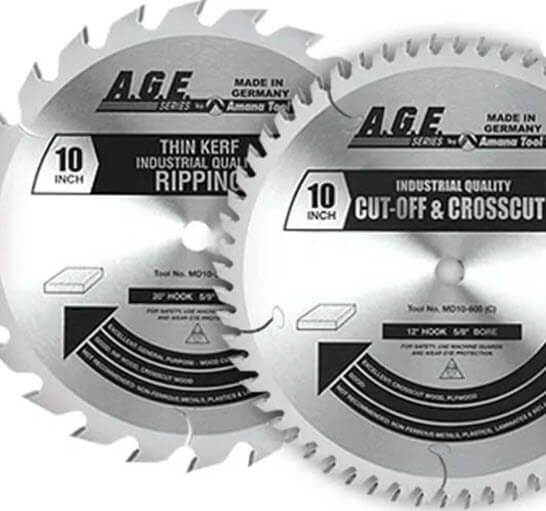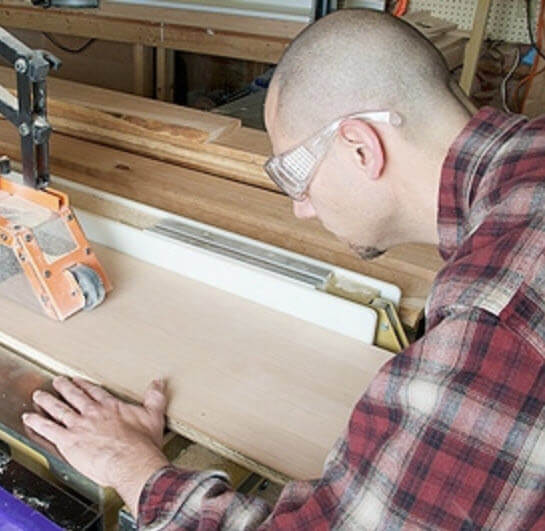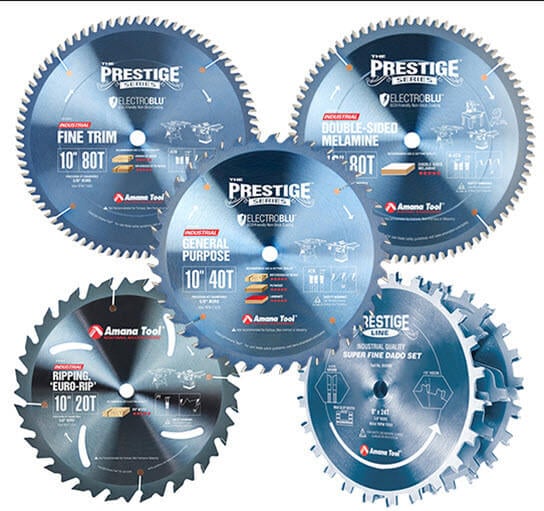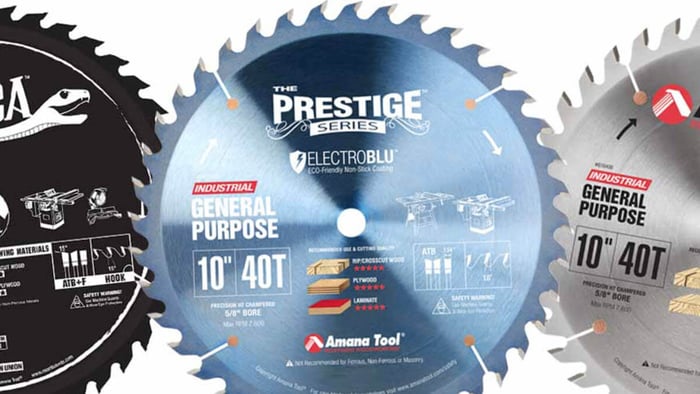
What Kind of Saw Blade - Rip, Cross-Cut, or Combination?
Picking the right saw blade will save time, reduce tear‑out, and give you cleaner cuts. This guide explains the differences in tooth geometry, gullet size, hook angle, and kerf — and when to choose each blade for the job.
Why blade geometry matters
Every blade is a system: blade diameter, tooth grind, tooth count (TPI), gullet depth, hook angle, and carbide quality work together to determine how the blade behaves. Use a blade that matches the cut (rip vs cross‑cut) and the material (solid wood, plywood, laminate) and you'll get cleaner cuts, less motor strain, and longer tool life.

Ripping Saw Blades — fast material removal
Purpose: Cutting with the grain (ripping). These blades are optimized to remove wood quickly and efficiently.
Key design traits
- Tooth count: Low — commonly 24–30 teeth on a 10" blade.
- Grind: Flat Top Grind (FTG) for a chisel‑like cutting action.
- Gullets: Large gullets to clear big chips fast.
- Hook angle: Positive (often high), which helps pull the blade through the wood for faster feed rates.
Performance and best uses
Rip blades excel at dimensioning lumber and long rips where speed is more important than a glass‑smooth finish. They leave a rougher surface that usually needs jointing, planing, or sanding afterward. They’re also kinder to saw motors during heavy ripping because chips are evacuated easily.

Crosscut Saw Blades — clean slicing across the grain
Purpose: Cutting across the grain (cross‑cut). These blades slice wood fibers cleanly to reduce tear‑out and produce a finished edge.
Key design traits
- Tooth count: High — typically 60–80 teeth on a 10" blade.
- Grind: Alternating Top Bevel (ATB) to shear fibers instead of tearing them.
- Gullets: Shallow — each tooth removes less material per pass.
- Hook angle: Low or negative to control aggression and reduce splintering on veneers and laminates.
Performance and best uses
Cross‑cut blades are the go‑to for cabinet parts, furniture components, and any visible edge where tear‑out must be minimized. They require slower feed rates and more power than rip blades, and are not suited to fast, heavy ripping.

Combination (General‑Purpose) Saw Blades — the practical compromise
Purpose: A single blade intended to handle both ripping and cross‑cutting reasonably well.
Key design traits
- Tooth count: Medium — commonly 40–50 teeth on a 10" blade.
- Grind: Hybrid patterns (e.g., sequences of ATB teeth followed by FTG rakers).
- Gullets: Medium size to balance chip clearing and finish quality.
- Hook angle: Moderate positive to keep things moving without aggressive tear‑out.
Performance and best uses
Combo blades are ideal for jobsite saws, hobbyists, and small shops that prefer fewer blade swaps. They won’t match a dedicated cross‑cut for finish or a rip blade for pure speed, but they’re versatile and practical for mixed workloads.
Other blade considerations
- Kerf width: Thin‑kerf blades (≈3/32") remove less material and are easier to cut with underpowered saws. Full‑kerf (≈1/8") resists deflection and stays truer on heavy duty saws but needs more horsepower.
- Carbide tip quality: Higher quality carbide lasts longer between sharpenings and tolerates more resharpen cycles.
- Blade diameter and RPM: Always match blade size to your saw. Larger blades typically run slower RPM and cut deeper; the tooth geometry should be tuned for the RPM range it will see.
- Material specifics: Melamine and laminate need special blades or scoring blades to avoid chip‑out. Cutting non‑ferrous metal or plastics requires blades designed for those materials.
- Maintenance: Keep blades clean and sharp. Resin build‑up and dull carbide dramatically reduce performance and increase the chance of burning or tear‑out.
Practical shop tips
- Match blade to primary task: If you mostly do rips, buy a dedicated rip blade. If you do finish work, invest in a high‑tooth cross‑cut blade.
- Use a combo blade for flexibility: When you need one blade that handles most jobs acceptably, a 40–50T combo is the best choice.
- Consider thin kerf for portable saws: If your table or jobsite saw is underpowered, thin‑kerf blades reduce motor strain and lessen tear‑out on long cuts.
- Tune feed and speed: Slow your feed for high‑TPI blades and speed up slightly for rip blades — the blade geometry expects different chip loads.
- Scoring and zero‑clearance inserts: For veneered plywood and melamine, use a scoring blade or zero‑clearance insert to prevent edge tear‑out.
Saw Blade Decision Chart
| Primary Task | Recommended Blade | Notes |
|---|---|---|
| Fast ripping of dimensional lumber | Rip blade (FTG) | Low teeth, deep gullets — faster cuts, rougher finish |
| Finish cross‑grain cuts, joinery | Cross‑cut (ATB) | High tooth count — clean edges, slower feed |
| Mixed shop work / jobsite | Combination (40–50T) | Balanced performance — fewer blade changes |
| Veneer / melamine | Fine‑tooth cross‑cut or scored cut | Use scoring or zero‑clearance for best edge quality |
Recommended accessories & services
Keep a zero‑clearance throat plate, a decent blade wrench, and a small selection of dedicated blades (rip, cross‑cut, and a combo) if you can. If you don’t want to resharpen yourself, consider a local sharpening service with carbide sharpening capability.
FAQs
What is the difference between a rip blade and a cross-cut blade?
A rip blade is designed for cutting along the grain, with fewer teeth and large gullets for fast chip removal. A cross-cut blade has many more teeth and beveled edges to slice across the grain cleanly with minimal tear-out.
Can I use a combination blade for all types of cuts?
Yes, a 40–50 tooth combination blade can handle both rip and cross-cut tasks, making it a practical choice for general woodworking. However, it won’t perform as quickly as a dedicated rip blade or as cleanly as a fine cross-cut blade.
How many teeth should a table saw blade have?
It depends on the cut. A 10" rip blade usually has 24–30 teeth for fast ripping. Cross-cut blades often have 60–80 teeth for smooth finishes. Combination blades fall in between, with about 40–50 teeth.
What is the advantage of a thin-kerf saw blade?
Thin-kerf blades remove less material, so they require less power to cut. This makes them a good choice for smaller or portable saws. They also waste less wood, but may deflect more easily than full-kerf blades.
When should I replace or sharpen a saw blade?
Replace or resharpen your blade when you notice burning, tear-out, or excessive effort while cutting. Dull teeth or built-up resin reduce performance and strain your saw. Quality carbide blades can be sharpened multiple times before needing replacement.




